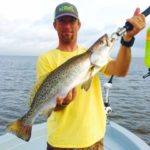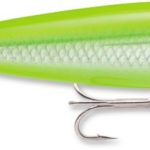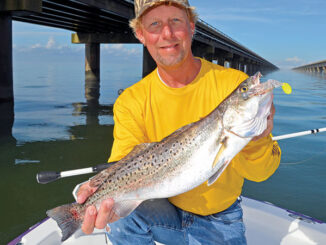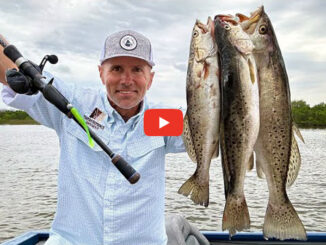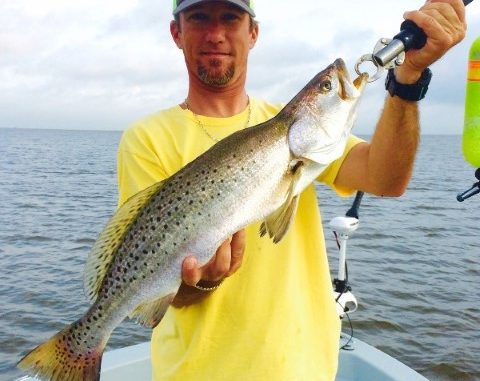
Paddletails, grubs and topwaters will all perform
When Kirk Stansel, a veteran charter boat captain, wants to catch speckled trout in the Calcasieu Lake area in April, he fishes the Ship Channel from Lake Charles to the Intracoastal Waterway.
Some days he’ll fill the box with school-sized speckled trout. Some days he’ll catch an 8-pounder, plus load up the box. And some days, well, he said, “April is one of the windiest and toughest months for fishing, especially for speckled trout. April’s a transition month for speckled trout. You can catch them one day at a spot and go back the next day and they aren’t there.”
That’s why it’s best to keep moving. Stansel, along with his brothers has owned Hackberry Rod & Gun on the west side of Calcasieu Lake for 13 years. Drift or, more often than not, let the wind push the boat along either the western shoreline or the eastern shoreline of that stretch. Stansel said he has no favorite side.
“I like them both,” he said. “The whole Ship Channel has flats on both sides of it.
“Drift the edges of the Ship Channel and stay in 6- to 8-feet of water. Pick a shoreline and make a drift working the bottom. In April, they’ll be deep most of the time. It’s best on a falling tide. Work the bait with the tide.”
Often, redfish and flounder will be mixed in with the speckled trout, he said, which is lagniappe on a spring outing.
Stansel said he doesn’t specifically look for bait, but if there are baitfish and other food sources present, definitely target that area. It’s generally later on in the year and in the lake itself that he looks for bait.
Points and structure are likely hotspots, he said.
“A lot of times the fish set up in a spot to ambush the bait,” he said. “That’s why I like working with the current better.
“Find a point where the current hits it. Or pilings, bulkheads, rock walls … If you find any kind of structure, fish it.”
His preference is a soft plastic on either a 1/8- to 3/8-ounce leadhead. The weight hinges on the wind and the current, he said. Naturally, he tries to fish with the lightest leadhead possible.
“The stronger the wind, the stronger the current, the heavier you have to go,” he said. “The lighter you can get away with, the better.”
Stansel’s rule of thumb for colors depends on water clarity. The clearer it is use the brighter colors. The muddier it is use the darker colors. For example, if there is 3 or 4 inches of clarity, he ties on purple/chartreuse or black/red with a chartreuse tail. If it’s clear, tie on glow/chartreuse or limetreuse.
He favors either Hackberry Hustlers, which feature a paddle tail, or H&H Salty Grubs, which have a straight tail. Sometimes the fish want the paddle tail, sometimes they don’t. The key is to have anglers in the boat throw one or the other until you find what the fish are hungry for that day.
He fishes with 10- or 12-pound test monofilament line or with 20- or 30-pound test braided line. He always uses a 20- or 30-pound monofilament leader tied with either a surgeon’s knot or a uni knot. If you choose a surgeon’s knot to join mono and braid, he said, use no fewer than four wraps. Otherwise, there’ll be knot slippage.
If the water’s clear where he’s fishing along the Ship Channel, Stansel said he will offer a topwater such as a bone Super Spook or a chartreuse Skitterwalk.
